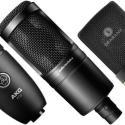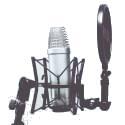Dynamic vs Condenser Mic: Differences & Strengths Explained
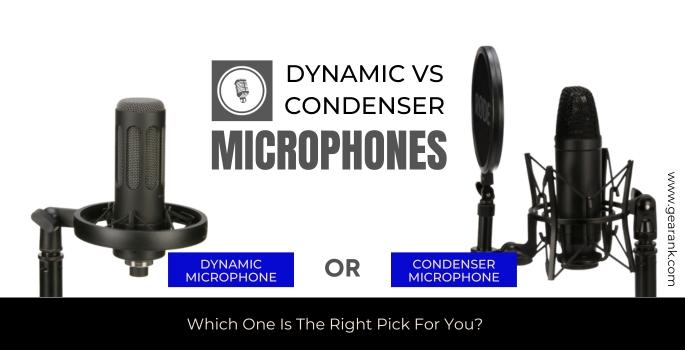
When it comes to microphones, there is no such thing as a one-size-fits-all solution. How you use them will depend on the instruments you're recording and your situation.
While there may be overlapping types of mics, they are designed with different specifications that set them apart.
Dynamic vs condenser mic--these are two of the most common types of microphones. Each has its own strengths and weaknesses in terms of design and sound quality.
In this article, we will provide a detailed comparison of condenser and dynamic mics and explain how to use them in different situations.
We have also included a short FAQ section at the end to answer any additional questions you may have.
How Do Microphones Convert Sound Waves?
Dynamic and condenser microphones share the same operating principles, although their designs differ in terms of moving parts and materials.
Consider a dynamic microphone as an example and examine its components to gain a more in-depth understanding:
-
Diaphragm
-
Coil
-
Magnet
-
Capsule
Transduction is the process through which microphones convert sound waves into electrical signals.
When the sound waves hit the diaphragm inside the microphone and undergoes a back-and-forth movement, which is then transferred to a small metal coil.
The metal coil interacts with the magnetic core, generating a strong magnetic field. Finally, the capsule of the microphone receives the electric signal, which subsequently goes through the rest of the signal chain up until the speakers.
The materials used will determine how well a mic reproduces the original sound.
Different microphones are designed to be used in different situations, and choosing the right one is crucial for optimal sound quality.
Dynamic and condenser microphones differ in their sensitivity to sound pressure levels (SPL) and frequency response.
Dynamic mics use a coil and magnet to transform physical vibrations into an electrical audio signal. Condensers have a back plate along with a diaphraghm coated with a conductive material. As a result, they react differently to sound due to differences in their response time.
Quick Summary of Polar Patterns
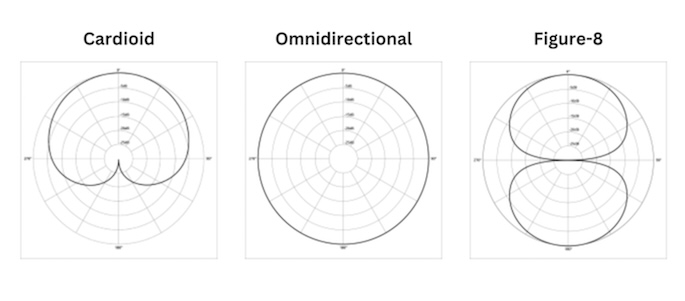
Microphones have different directional sensitivities, which are described by polar patterns. These patterns indicate the areas where the microphone is most sensitive to sound.
Most microphones come with a chart that details the sensitivity of each point on the polar pattern. The three main polar patterns are cardioid, omnidirectional, and figure-8.
1. Cardioid
Due to its popularity, the cardioid polar pattern is widely used in dynamic microphones. It exhibits maximal sensitivity to the front while being less sensitive to the rear and sides.
2. Omnidirectional
The omnidirectional polar pattern is commonly found in most condenser microphones. This pattern can capture sound signals from various directions, including front, rear, and side angles.
3. Figure-8 or Bidirectional
This particular polar pattern is commonly used in stereo recording applications due to its ability to capture front and rear signals while rejecting sound coming from the sides of the microphone. For a more in-depth analysis, we have published an article that delves into the technicalities of polar patterns and their operational principles.
Dynamic Microphones
Dynamic microphones are designed to be durable and rugged, making them ideal for use in live performance. They can handle high sound pressure levels before producing any distortion, thanks to a diaphragm and moving coil attached to a magnet. A corresponding electrical signal is generated as sound waves cause the diaphragm to vibrate.
Most dynamic mics don't require an external power source, making them a convenient plug-and-play option for audio gear with an XLR cable connected to a mixer or an audio interface. They also excel at capturing loud and punchy sounds, thanks to their ability to resist distortion.
This makes them a great choice for:
-
Live performance
-
Recording loud vocals
-
Capturing transient heavy sounds such as drums or percussion.
-
Good for recording high-SPL guitar and bass amps.
Dynamic Mic Polar Pattern

Most dynamic microphones typically feature a cardioid polar pattern, which makes them highly responsive to sound coming from the front while minimizing sensitivity to sound originating from the sides or rear.
However, some variations of this polar pattern exist in different dynamic mic brands. For instance, the supercardioid and hypercardioid polar patterns exhibit greater rear sensitivity than the cardioid pattern while also providing superior sound isolation. This is what makes mics like the Shure SM58 and Samson Q2U very popular for vocals.
Potential Drawbacks
Dynamic microphones are known for their ruggedness and durability, but they have certain limitations worth bearing in mind. One of the main drawbacks is their low sensitivity to sound, making them less suitable for recording softer sounds compared to more sensitive condenser microphones. This is due to the fact that dynamic mics are designed to handle high-energy transients.
Another limitation of dynamic mics is their restricted frequency response, primarily attributed to their compact and portable design.
This can make them more susceptible to sharp plosives and proximity effect, where low frequencies are amplified as the sound source gets closer to the mic.
These limitations may be acceptable for specific applications but are essential when selecting a microphone for recording or live sound purposes.
Condenser Microphones
Condenser microphones are the top choice among professionals in music studios because of their exceptional ability to capture high-quality audio with great detail and accuracy. These microphones utilize a thin diaphragm separated from a metal backplate by a few millimeters.
When a sound wave hits the condenser, the diaphragm vibrates, creating positive and negative states that cause variations in the distance between the diaphragm and the fixed backplate.
These variations in distance result in an electrical signal that accurately captures the sound's nuances and subtleties. To achieve the best possible transient and frequency response, condenser microphones require internal circuitry with an external power source like phantom power (48v).
These microphones are relatively larger and more expensive than other types, but their sensitivity to the finer details of the sound makes them an ideal choice for recording professionals who demand the highest level of audio quality.
This makes them a great choice for:
-
Recording solo or group vocals
-
Drum overhead mics
-
Sounds that have a wide dynamic and frequency range
There are two main types of condenser microphones: large diaphragm and small diaphragm condensers.
The size of a microphone's diaphragm is essential in capturing sound waves during recording. Microphones with a diaphragm diameter of less than 0.75 inches are known as small diaphragm microphones, while those with a diameter greater than 0.75 inches are classified as large diaphragm condenser microphones.
Small diaphragm condenser microphones, commonly called pencil microphones, are engineered to capture high-frequency and transient sounds with greater precision. Their design facilitates the production of transparent, natural-sounding audio that is highly accurate with great placement options.
For this reason, professional audio engineers often opt for small diaphragm condenser microphones when recording acoustic instruments in stereo such as acoustic guitars, pianos, and drums.
You'll find small diaphragm mics commonly used in:
-
Orchestras
-
Choirs
-
Acoustic guitars
-
Cymbals and Hihats
-
Small percussions
Large-diaphragm condenser microphones are revered for their exceptional low-frequency response. They can augment the tonality and profundity of sounds that might otherwise come across as uninteresting.
Audio professionals highly esteem these microphones for their ability to add a rich, full-bodied quality to recordings, depending on the desired effect.
You'll find large-diaphragm mics commonly used in:
-
Solo or group vocals
-
Guitar or bass amps
-
As drum overheads
-
Acoustic guitar
-
Big brass instruments.
Condenser Mic Polar Pattern
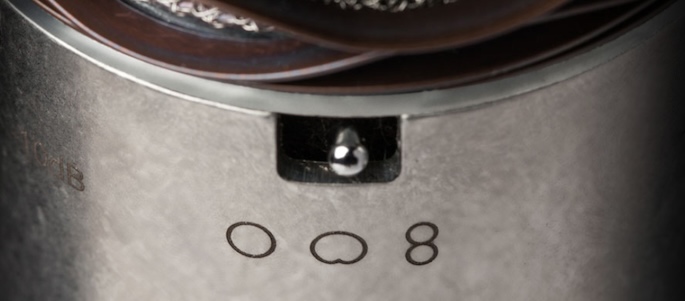
Condenser microphones are highly versatile and offer one or more switchable polar patterns, such as cardioid, omnidirectional, and Figure-8. These polar patterns enable the user to adjust the microphone's directionality, making it suitable for various recording scenarios.
In contrast, dynamic mics are limited to one polar pattern, which reduces their flexibility. The adaptability of condenser microphones is both a convenience and a vital requirement for meeting different recording needs.
Potential Drawbacks
Condenser microphones are highly sensitive to sound, which can be both an advantage and a disadvantage. However, if the microphone is not positioned correctly away from a loud sound source, it may cause damage to the diaphragm of your condenser.
Some condenser mics have incredibly fragile vacuum tubes. Compared to dynamic microphones, tube condenser mics are much more delicate and easily damaged if not handled carefully.
Additionally, they require an external power source, typically a phantom power supply, which limits their compatibility with specific audio devices. Tube condenser microphones have an external power supply, which limits their feasibility for live use.
Dynamic And Condenser Microphones: Which One Is The Right Pick For You?
There is a considerable amount of functional similarity between both condenser and dynamic microphones, making it difficult to differentiate between them. While some users prefer experimenting with different mic options, others opt for a more straightforward approach. The following fundamental questions can help to determine the appropriate microphone
-
What Is Your Sound Source?
-
What Is Your Recording Environment?
-
What Is Your Budget?
What Is Your Sound Source?
For professionals looking to capture audio recordings, the choice of microphone will depend on the type of instrument being recorded. If the sound source is a loud instrument like a bass drum, electric guitar, or bass guitar amplifier, then a dynamic microphone is recommended due to its ability to handle high sound pressure levels.
However, if the goal is to capture sounds with a wide dynamic range and frequencies - such as in podcasting or recording vocals, acoustic guitars, or soft instruments - then a condenser microphone is preferable for its more sensitive and detailed sound capture capabilities. A condenser mic is the safest pick when looking for a good stream and podcast microphone.
What Is Your Recording Environment?
Dynamic microphones are the way to go when it comes to audio recording in noisy environments like live concerts or bustling streets. These microphones are ideal for situations where you want to isolate sound to the source without picking up noise from all directions.
Dynamic mics are unidirectional and can capture sound only from where they are pointed while rejecting sound from the sides and rear. This makes them much less sensitive to background noise, allowing you to capture high-quality audio that requires minimal editing.
On the other hand, if you're recording in a room or environment that is acoustically treated, a condenser microphone is a better choice. These highly sensitive mics can capture instruments and studio vocals, with great detail and clarity. They're perfect for situations where you want to capture every nuance of the sound being recorded. However, they're also more prone to picking up background noise to be better for noisy environments.
What Is Your Budget?
The budget you allocate for your recording project directly impacts the microphones you can choose from. If you seek an affordable solution, you don't have to invest in both types of microphones.
Gearank has researched and evaluated the best condenser and dynamic microphones available when considering high-end or budget-friendly options.
Dynamic microphones are generally less expensive due to their simple design that doesn't require an external power source.
In contrast, condenser microphones have more complex construction and delicate moving parts, making them pricier than dynamic mics. High-end condenser microphones with built-in preamps or tubes can cost up to a thousand dollars.
Final Thoughts
Trying to choose between the two might seem like a daunting task but here's a simple rule of thumb:
Dynamic mics for live performances and rough environments.
Condenser microphones for controlled, acoustically-treated settings.
However, the decision is only sometimes straightforward, and experimentation is recommended.
It's essential to consider the specifics of your recording scenario, such as the type of sound you're trying to capture, whether it's clear vocals or live music.
Remember that no one microphone is best for every situation.
Ultimately, the choice of microphone depends on your unique recording requirements. Want to learn more about condenser vs dynamic microphones? Check out our FAQ section below for a more in-depth understanding of the differences between dynamic and condenser microphones.
Frequently Asked Questions
What Is A Phantom Power Supply?
Condenser microphones require a power supply, and Phantom power (48v) is the standard method. The phantom power is usually supplied by an audio interface, mixing console, or standalone phantom power supply unit. It is important to note that phantom power is essential for many microphones to operate effectively.
What Is A Frequency Response?
A microphone's ability to accurately reproduce sounds in different frequencies is called its frequency response. The microphone's frequency response is typically displayed as a graph or chart in the manual or brand website.
One helpful technique for analyzing frequency response is to use an EQ plugin in your DAW with a spectrum analyzer, which provides real-time data on how the microphone responds to different frequencies. This is more useful when testing looped guitar audio as vocals have too many variables.
What Is An XLR Microphone?
XLR microphones are a popular type of microphone in the audio industry. They use a sturdy and reliable XLR connector with three pins. The first pin is a ground wire that protects the microphone from electromagnetic interference.
The other two pins carry an audio signal, one with a positive charge and the other with a negative charge, creating a balanced signal path that results in a clearer and less noisy sound.
Which one is better? XLR Mics or USB Mics?
Experts widely regard XLR mics as the superior connector for microphones. With decades of successful use as a connector for amplifiers, speakers, audio interfaces, and mixers, the XLR connector is well-established. If you desire expandability and control over your sound, we highly recommend using an XLR mic.
On the other hand, USB connectors are known for their easy connectivity and user-friendliness, which makes them ideal for beginners in podcasting. However, they cannot connect with outboard gear and may produce static noise due to their lack of ground shield protection, which exposes the mic to excessive buzzing.
Contributors:
- Allen Articulo - Co-writer
- Jerry Borillo - Illustrator




